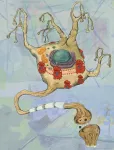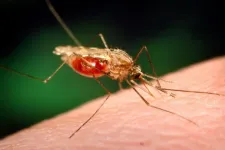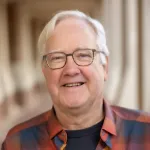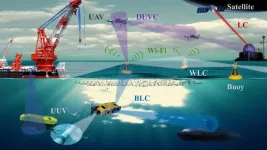(Press-News.org) LAWRENCE — A University of Kansas study of rare gene mutations that cause hereditary Alzheimer's disease shows these mutations disrupt production of a small sticky protein called amyloid.
Plaques composed of amyloid are notoriously found in the brain in Alzheimer’s disease and have long been considered responsible for the inexorable loss of neurons and cognitive decline. Using a model species of worm called C. elegans that’s often used in labs to study diseases at the molecular level, the research team came to the surprising conclusion that the stalled process of amyloid production — not the amyloid itself — can trigger loss of critical connections between nerve cells.
The research, appearing in the journal Cell Reports, was headed by Michael Wolfe, Mathias P. Mertes Professor of Medicinal Chemistry at KU.
The research team focused on the rare inherited mutations because these mutations are found in genes that encode proteins that produce amyloid.
“If we can understand what's happening in this inherited form of the disease where a single mutation can trigger it,” Wolfe said, “that might be a clue to what's going on in all the other cases.”
The rare mutations are particularly devastating, as they fate the mutation carrier to Alzheimer’s disease in middle age, and children of a mutation carrier have a 50% chance of inheriting the disease-causing mutation.
Wolfe said hereditary Alzheimer’s disease shows the same pathology, the same presentation clinically and the same progression of symptoms as the “common, garden-variety” of Alzheimer's related to old age.
“You see the same amyloid plaques in the hereditary disease,” he said. “We think that these inherited mutations, though rare, are key to what's going on with all Alzheimer’s disease.”
Wolfe, who earned his doctorate at KU and returned to the university seven years ago for collaborative research opportunities, joined forces with Brian Ackley, associate professor of molecular biology at KU, whose lab specializes in research with the C. elegans model worm. The research team also included other KU collaborators as well as investigators in Beijing, China, and at Harvard Medical School.
Co-authors with KU’s Department of Medicinal Chemistry were Sujan Devkota, Vaishnavi Nagarajan, Arshad Noorani and Sanjay Bhattarai; co-authors at KU’s Department of Molecular Biosciences were Ackley and Yinglong Miao; and co-authors from KU’s Center for Computational Biology were Hung Do and Anita Saraf. Other KU co-authors were Caitlin Overmeyer of the Graduate Program in Neurosciences and Justin Douglas of KU’s Nuclear Magnetic Resonance Core Lab. The KU personnel collaborated with Rui Zhou of Tsinghua University in Beijing and Masato Maesako of Harvard Medical School.
Wolfe said the discovery could point the way toward new approaches to Alzheimer’s therapies, and he hoped fellow researchers and developers of drug therapies would pay close attention to his team’s results.
“Our findings suggest what’s needed is a stimulator of the amyloid-producing enzyme, to restart stalled processes and address both problems: eliminating stalled protein complexes that lead to degeneration of nerve cell connections and producing more soluble forms of amyloid. This approach could address both contributing factors simultaneously.”
END
Study: Mutations in hereditary Alzheimer’s disease damage neurons without ‘usual suspect’ amyloid plaques
2024-02-29
ELSE PRESS RELEASES FROM THIS DATE:
Rice lab finds better way to handle hard-to-recycle material
2024-02-29
HOUSTON – (Feb. 29, 2024) – Glass fiber-reinforced plastic (GFRP), a strong and durable composite material, is widely used in everything from aircraft parts to windmill blades. Yet the very qualities that make it robust enough to be used in so many different applications make it difficult to dispose of ⎯ consequently, most GFRP waste is buried in a landfill once it reaches its end of life.
According to a study published in Nature Sustainability, Rice University researchers and collaborators have developed a new, energy-efficient upcycling method to transform glass fiber-reinforced plastic ...
Ice shell thickness reveals water temperature on ocean worlds
2024-02-29
ITHACA, N.Y. – Cornell University astrobiologists have devised a novel way to determine ocean temperatures of distant worlds based on the thickness of their ice shells, effectively conducting oceanography from space.
Available data showing ice thickness variation already allows a prediction for the upper ocean of Enceladus, a moon of Saturn, and a NASA mission’s planned orbital survey of Europa’s ice shell should do the same for the much larger Jovian moon, enhancing the mission’s findings about whether it could support ...
Garrett Isaac Neubauer Center for Cardiovascular Innovation launches at Columbia
2024-02-29
NEW YORK, NY (February 29, 2024)--Columbia University Vagelos College of Physicians and Surgeons (VP&S) today announced the launch of a new center for pediatric cardiovascular innovation, made possible through a visionary gift by Lawrence Neubauer. The mission of the new center is to improve outcomes for patients through groundbreaking research and care and to define the next cures for and future practice in congenital heart disease (CHD)—here and across the world.
In recognition of the transformative generosity of Lawrence Neubauer, the center will be named the Garrett Isaac Neubauer Center for Cardiovascular ...
MSU co-authored study: 10 insights to reduce vaccine hesitancy on social media
2024-02-29
EAST LANSING, Mich. — Effective population level vaccination campaigns are fundamental to public health. Countercampaigns, which are as old as the first vaccines, can disrupt uptake and threaten public health globally.
Even before March 2020, vaccine hesitancy was directly linked to misinformation — false, inaccurate information promoted as factual — on social media. Once COVID-19 reached pandemic status, social media was acknowledged as the epicenter of information leading to vaccine hesitancy, which the World Health Organization, ...
New study: Deforestation exacerbates risk of malaria for most vulnerable children
2024-02-29
Malaria kills more than 600,000 people each year worldwide, and two thirds are children under age five in sub-Saharan Africa. Scientists have found a treatment that could prevent thousands of these deaths: trees. New research conducted at the University of Vermont (UVM) and published today in the journal GeoHealth suggests forests can provide natural protection against disease transmission, particularly for the most vulnerable children.
Malaria spreads through the bite of Anopheles mosquitoes. While malaria is a disease long associated with lower socioeconomic status, the UVM study links deforestation with higher risk of the disease, particularly for ...
DOE announces plans to host an informational meeting and requests expressions of interest for the Thomas Jefferson National Accelerator Facility Management and Operating Contract Competition
2024-02-29
Washington, D.C. – The U.S. Department of Energy (DOE) announced the schedule for upcoming events and submissions associated with the competition for the management and operating contract for the Thomas Jefferson National Accelerator Facility (TJNAF).
TJNAF is a DOE national laboratory and DOE-sponsored Federally Funded Research and Development Center that has a mission focused on delivering breakthrough science and technology in nuclear physics.
DOE will host an informational meeting and site tour on March 27, 2024 at TJNAF to provide information regarding the site to interested parties. ...
Changes in flu circulation means US likely to see vaccines move from quadrivalent to trivalent
2024-02-29
U.S. flu vaccines are likely to move from quadrivalent to trivalent due to a change in circulating influenza viruses, says a University of Michigan researcher.
Currently, all influenza vaccines in the United States are quadrivalent, meaning that they protect against four different flu viruses.
In a new paper published in the New England Journal of Medicine, researchers detail the spread of influenza B/Yamagata virus, which has not been in circulation since early 2020; the regulatory discussions and recommendations on updating vaccines; and the manufacturing considerations ...
Accreditation with commendation awarded to the American College of Chest Physicians
2024-02-29
Glenview, IL– The American College of Chest Physicians® (CHEST) has received accreditation with commendation from the Accreditation Council for Continuing Medical Education (ACCME) and reaccreditation from the Society for Simulation in Healthcare (SSH).
This achievement grants CHEST reaccreditation through November 2029 and places the organization in the highest tier of all continuing medical education (CME) providers, including some of the nation’s most prestigious medical schools and professional medical societies.
“Receiving reaccreditation with commendation from the ACCME is a real testament to the education team at CHEST including both internal ...
Hahn awarded CZI grant to monitor, manipulate proteins important in nervous system function, neurological disease
2024-02-29
CHAPEL HILL, N.C. – The Chan Zuckerberg Initiative (CZI) announced four multi-year Exploratory Cell Networks grants for researchers exploring the frontiers of genomics, cell biology, and synthetic biology by developing new measurement technologies. The projects will be bringing together regional labs in California, the Mid-Atlantic, and the Research Triangle.
Klaus Hahn, PhD, the Ronald G. Thurman Distinguished Professor of Pharmacology and member of the UNC Lineberger Comprehensive Cancer Center, will be co-leading a ...
All-light communication network bridges space, air and sea for seamless connectivity
2024-02-29
WASHINGTON — Researchers have developed an all-light communication network that enables seamless connectivity across space, air and underwater environments. The new network design combines different types of light sources to ensure connectivity no matter the environment.
“In today’s world, data transmission is critical for communication, navigation, emergency response, research and commercial activities,” said research team leader Yongjin Wang from Nanjing University of Posts and Telecommunications and ...







